一、SparkSQL的进化之路
1.0以前:
Shark
1.1.x开始:
SparkSQL(只是测试性的) SQL
1.3.x:
SparkSQL(正式版本)+Dataframe
1.5.x:
SparkSQL 钨丝计划
1.6.x:
SparkSQL+DataFrame+DataSet(测试版本)
x:
SparkSQL+DataFrame+DataSet(正式版本)
SparkSQL:还有其他的优化
StructuredStreaming(DataSet)
二、认识SparkSQL
2.1 什么是SparkSQL?
spark SQL是spark的一个模块,主要用于进行结构化数据的处理。它提供的最核心的编程抽象就是DataFrame。
2.2 SparkSQL的作用
提供一个编程抽象(DataFrame) 并且作为分布式 SQL 查询引擎
DataFrame:它可以根据很多源进行构建,包括:结构化的数据文件,hive中的表,外部的关系型数据库,以及RDD
2.3 运行原理
将 Spark SQL 转化为 RDD, 然后提交到集群执行
2.4 特点
(1)容易整合
(2)统一的数据访问方式
(3)兼容 Hive
(4)标准的数据连接
2.5 SparkSession
SparkSession是Spark 2.0引如的新概念。SparkSession为用户提供了统一的切入点,来让用户学习spark的各项功能。
在spark的早期版本中,SparkContext是spark的主要切入点,由于RDD是主要的API,我们通过sparkcontext来创建和操作RDD。对于每个其他的API,我们需要使用不同的context。例如,对于Streming,我们需要使用StreamingContext;对于sql,使用sqlContext;对于Hive,使用hiveContext。但是随着DataSet和DataFrame的API逐渐成为标准的API,就需要为他们建立接入点。所以在spark2.0中,引入SparkSession作为DataSet和DataFrame API的切入点,SparkSession封装了SparkConf、SparkContext和SQLContext。为了向后兼容,SQLContext和HiveContext也被保存下来。
SparkSession实质上是SQLContext和HiveContext的组合(未来可能还会加上StreamingContext),所以在SQLContext和HiveContext上可用的API在SparkSession上同样是可以使用的。SparkSession内部封装了sparkContext,所以计算实际上是由sparkContext完成的。
特点:
----为用户提供一个统一的切入点使用Spark 各项功能
----允许用户通过它调用 DataFrame 和 Dataset 相关 API 来编写程序
----减少了用户需要了解的一些概念,可以很容易的与 Spark 进行交互
----与 Spark 交互之时不需要显示的创建 SparkConf, SparkContext 以及 SQlContext,这些对象已经封闭在 SparkSession 中
2.7 DataFrames
在Spark中,DataFrame是一种以RDD为基础的分布式数据集,类似于传统数据库中的二维表格。DataFrame与RDD的主要区别在于,前者带有schema元信息,即DataFrame所表示的二维表数据集的每一列都带有名称和类型。这使得Spark SQL得以洞察更多的结构信息,从而对藏于DataFrame背后的数据源以及作用于DataFrame之上的变换进行了针对性的优化,最终达到大幅提升运行时效率的目标。反观RDD,由于无从得知所存数据元素的具体内部结构,Spark Core只能在stage层面进行简单、通用的流水线优化。
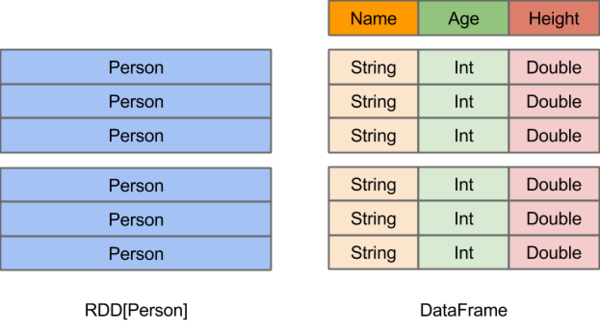
三、RDD转换成为DataFrame
使用spark1.x版本的方式
测试数据目录:/home/hadoop/apps/spark/examples/src/main/resources(spark的安装目录里面)
people.txt

3.1 方式一:通过 case class 创建 DataFrames(反射)
//定义case class,相当于表结构
case class People(var name:String,varage:Int)objectTestDataFrame1 {
def main(args: Array[String]): Unit={
val conf= new SparkConf().setAppName("RDDToDataFrame").setMaster("local")
val sc= newSparkContext(conf)
val context= newSQLContext(sc)//将本地的数据读入 RDD, 并将 RDD 与 case class 关联
val peopleRDD = sc.textFile("E:\\666\\people.txt")
.map(line=> People(line.split(",")(0), line.split(",")(1).trim.toInt))
import context.implicits._//将RDD 转换成 DataFrames
val df =peopleRDD.toDF//将DataFrames创建成一个临时的视图
df.createOrReplaceTempView("people")//使用SQL语句进行查询
context.sql("select * from people").show()
}
}
运行结果
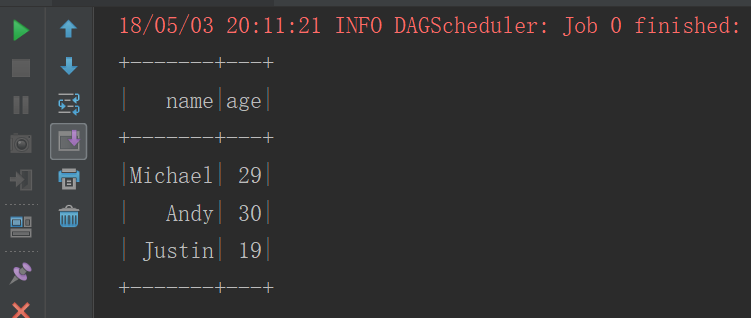
3.2 方式二:通过 structType 创建 DataFrames(编程接口)
objectTestDataFrame2 {
def main(args: Array[String]): Unit={
val conf= new SparkConf().setAppName("TestDataFrame2").setMaster("local")
val sc= newSparkContext(conf)
val sqlContext= newSQLContext(sc)
val fileRDD= sc.textFile("E:\\666\\people.txt")//将 RDD 数据映射成 Row,需要 import org.apache.spark.sql.Row
val rowRDD: RDD[Row] = fileRDD.map(line =>{
val fields= line.split(",")
Row(fields(0), fields(1).trim.toInt)
})//创建 StructType 来定义结构
val structType: StructType =StructType(//字段名,字段类型,是否可以为空
StructField("name", StringType, true) ::
StructField("age", IntegerType, true) :: Nil
)/**
* rows: java.util.List[Row],
* schema: StructType
**/val df: DataFrame=sqlContext.createDataFrame(rowRDD,structType)
df.createOrReplaceTempView("people")
sqlContext.sql("select * from people").show()
}
}
运行结果
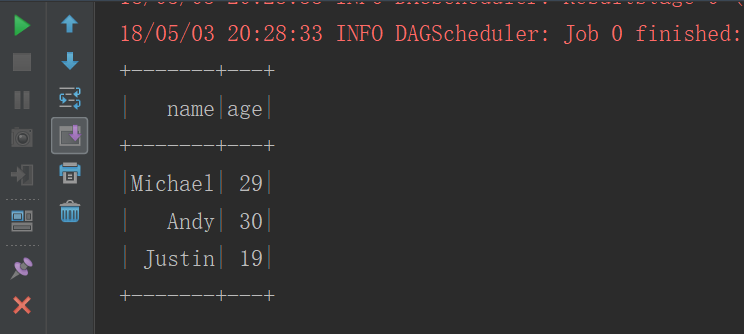
3.3 方式三:通过 json 文件创建 DataFrames
objectTestDataFrame3 {
def main(args: Array[String]): Unit={
val conf= new SparkConf().setAppName("TestDataFrame2").setMaster("local")
val sc= newSparkContext(conf)
val sqlContext= newSQLContext(sc)
val df: DataFrame= sqlContext.read.json("E:\\666\\people.json")
df.createOrReplaceTempView("people")
sqlContext.sql("select * from people").show()
}
}
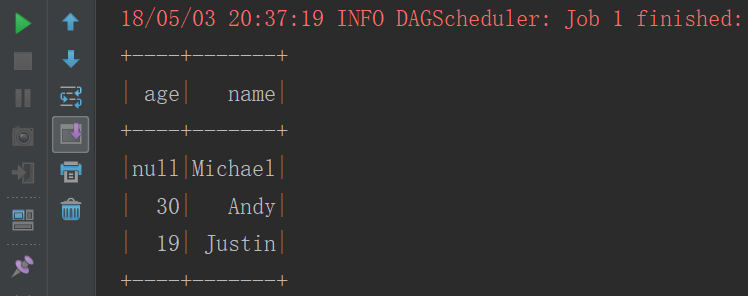
四、DataFrame的read和save和savemode
4.1 数据的读取
objectTestRead {
def main(args: Array[String]): Unit={
val conf= new SparkConf().setAppName("TestDataFrame2").setMaster("local")
val sc= newSparkContext(conf)
val sqlContext= newSQLContext(sc)//方式一
val df1 = sqlContext.read.json("E:\\666\\people.json")
val df2= sqlContext.read.parquet("E:\\666\\users.parquet")//方式二
val df3 = sqlContext.read.format("json").load("E:\\666\\people.json")
val df4= sqlContext.read.format("parquet").load("E:\\666\\users.parquet")//方式三,默认是parquet格式
val df5 = sqlContext.load("E:\\666\\users.parquet")
}
}
4.2 数据的保存
objectTestSave {
def main(args: Array[String]): Unit={
val conf= new SparkConf().setAppName("TestDataFrame2").setMaster("local")
val sc= newSparkContext(conf)
val sqlContext= newSQLContext(sc)
val df1= sqlContext.read.json("E:\\666\\people.json")//方式一
df1.write.json("E:\\111")
df1.write.parquet("E:\\222")//方式二
df1.write.format("json").save("E:\\333")
df1.write.format("parquet").save("E:\\444")//方式三
df1.write.save("E:\\555")
}
}
4.3 数据的保存模式
使用mode
df1.write.format("parquet").mode(SaveMode.Ignore).save("E:\\444")
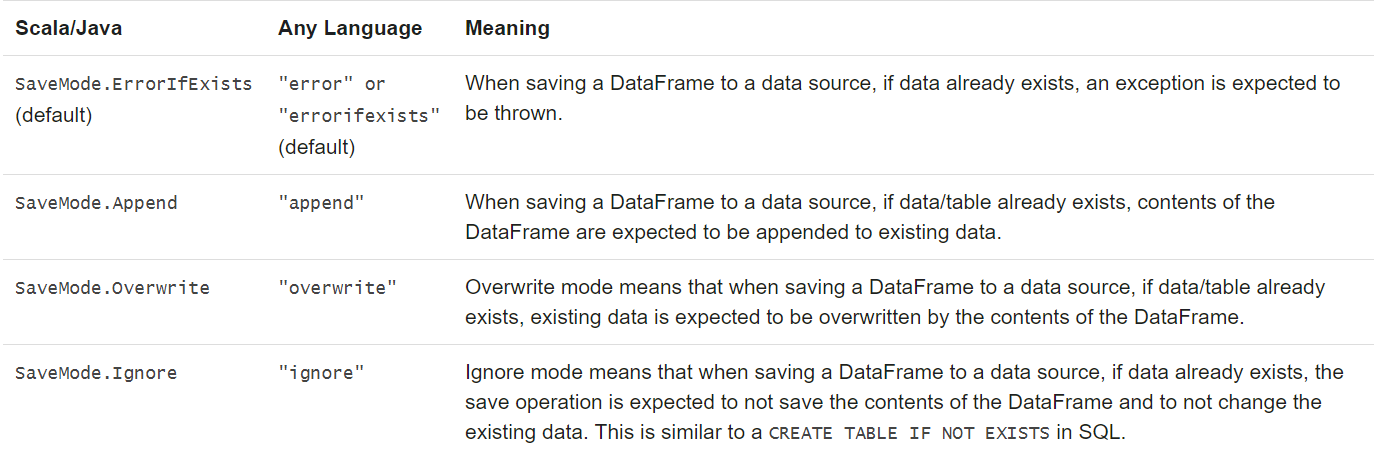
五、数据源
5.1 数据源只json
参考4.1
5.2 数据源之parquet
参考4.1
5.3 数据源之Mysql
objectTestMysql {
def main(args: Array[String]): Unit={
val conf= new SparkConf().setAppName("TestMysql").setMaster("local")
val sc= newSparkContext(conf)
val sqlContext= newSQLContext(sc)
val url= "jdbc:mysql://192.168.123.102:3306/hivedb"val table= "dbs"val properties= newProperties()
properties.setProperty("user","root")
properties.setProperty("password","root")//需要传入Mysql的URL、表明、properties(连接数据库的用户名密码)
val df =sqlContext.read.jdbc(url,table,properties)
df.createOrReplaceTempView("dbs")
sqlContext.sql("select * from dbs").show()
}
}
运行结果

5.4 数据源之Hive
(1)准备工作
在pom.xml文件中添加依赖
org.apache.spark
spark-hive_2.11
2.3.0
开发环境则把resource文件夹下添加hive-site.xml文件,集群环境把hive的配置文件要发到$SPARK_HOME/conf目录下
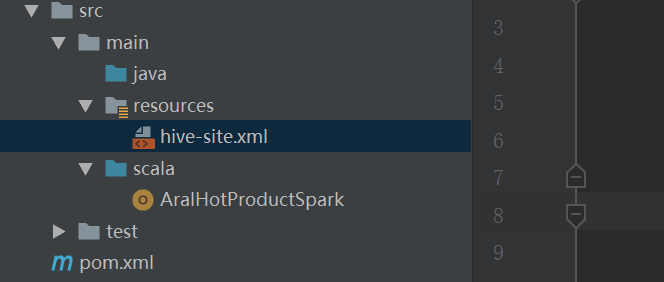
javax.jdo.option.ConnectionURL
jdbc:mysql://localhost:3306/hivedb?createDatabaseIfNotExist=true
JDBC connect string for a JDBC metastore
javax.jdo.option.ConnectionDriverName
com.mysql.jdbc.Driver
Driver class name for a JDBC metastore
javax.jdo.option.ConnectionUserName
root
username to use against metastore database
javax.jdo.option.ConnectionPassword
root
password to use against metastore database
hive.metastore.warehouse.dir
/hive/warehouse
hive default warehouse, if nessecory, change it
(2)测试代码
object TestHive {
def main(args: Array[String]): Unit = {
val conf = new SparkConf().setMaster("local").setAppName(this.getClass.getSimpleName)
val sc = new SparkContext(conf)
val sqlContext = new HiveContext(sc)
sqlContext.sql("select * from myhive.student").show()
}
}
运行结果
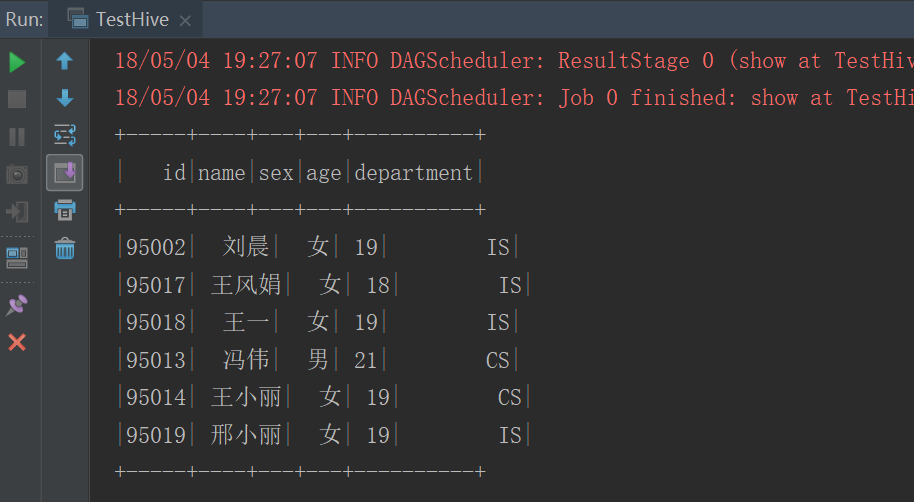
:taro路由跳转)
)




:taro路由参数)

WebSphere MQ安装过程)

:资源文件处理)







:大写px 控制样式)
